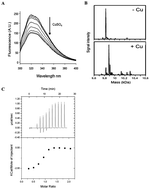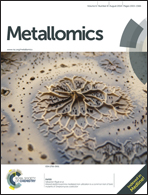Cu binding by the Escherichia coli metal-efflux accessory protein RcnB†
Abstract
Divalent cations play fundamental roles in biological systems where they act as structural and reactive determinants. Their high reactivity with biomolecules has forced living cells to evolve specific pathways for their in vivo handling. For instance the excess of metal can be expelled by dedicated efflux systems. The E. coli RcnA efflux pump expels both Ni and Co. This pump functions together with the periplasmic protein RcnB to maintain metal ion homeostasis. To gain insights into the efflux mechanism, metal binding properties of RcnB were investigated. Initial screening of metal ions by fluorescence quenching revealed Cu as a potential ligand for RcnB. Non-denaturing mass spectrometry and ITC experiments revealed the binding of one Cu ion per monomer with a micromolar affinity. This set of in vitro techniques was broadened by in vivo experiments that showed the accuracy of Cu binding by RcnB. RcnB implication in Cu detoxification was questioned and growth experiments as well as transcriptional analysis excluded a role for RcnB in Cu adaptation. Finally a mutant in a conserved methionine residue (Met86) displayed altered Cu binding. This mutant protein when tested for its Ni and Co resistance capacity was unable to complement an rcn mutant. Taken together these data show that RcnB is a new Cu-binding protein that is strikingly involved in a Ni/Co efflux system.


 Please wait while we load your content...
Please wait while we load your content...